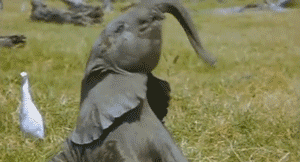Reading to Learn

Trumpeting to Summarization
Rationale: After children can read accurately and fluently they will soon be able to read in order to learn. The ultimate goal of reading is comprehension, and students at this level are ready to take on this task. This lesson introduces students to a helpful strategy called summarization and to help them read to learn. Students will learn to delete trivial information in an article about elephants, which will only leave them the important facts in the end.
Materials:
-
Pencils (one for each student)
-
Paper (one for each student)
-
Highlighters (one for each student)
-
Passage sample on Smart Board of "Elephants”
-
Dry erase markers
-
Rubric for grading summaries
-
Comprehension Questions
-
Class set of the article "Elephants" by Duckster
Procedures: Today, we are going to be learning how to summarize an article! This is when you condense the information down to only what is most important by deleting the trivial and repeated information. We are going to practice how to do this skill with two different articles. We will focus on what the main idea is, what facts support the main idea, and what information we can remove.
Say: Now we are going to read a message together on the Smart Board. This passage is on Elephants. Which continents do elephants live on Africa, Asia, or Europe? They live in Africa and Asia. Do they eat meat or plants? Correct! They eat plants. Let’s read more about our friends the Elephants. Follow along with me as I read this passage out loud. Show first paragraph of Elephants article on Smart Board.
Say: Who can sum up what you just read? Wait for students to give their summaries and write down what they say. Let’s take a look at my copy of this paragraph on the Smart Board. Notice how I highlighted important details and crossed out details that were not important. That helps me keep facts straight and the main idea in mind. Model the sample below on board.
There are two main types of elephants: the African elephant and the Indian elephant.
African elephant - The African elephant is bigger than the Indian elephant. It has larger ears, too. Both the males and females have tusks. The African elephant has wrinkly gray skin, a swayed back, and two tips at the end of its trunk that it can use like fingers to pick stuff up.
Indian elephant - The Indian, or Asian, elephant is smaller than the African elephant and has smaller ears. They have more of a humped back and only one fingerlike tip at the end of their trunk. Also, their skin tends to be less wrinkly than the African elephant.
Explain: To review, the main topic or first sentence tells us what the paragraph will be about. Our first sentence talked about how there are two types of elephants, so we highlight it. And then the paragraph tells us about the differences and similarities between the types of elephants. This is great information, but we want to focus on the differences so we can cross out the sentence about their tusks. Then it tells us how their ears are different. That’s great information because it is a difference! We are summarizing the article about elephants and their differences.
Now the students will practice what they have just learned on their own. Pass out a copy of the African Elephant article to each student to mark and highlight on. “I am passing out a text about a species of elephant known as the African Elephant, for you to read and highlight the important things. Have you ever been to a safari? What about a zoo that had elephants? This is a really interesting text that will make you think of this animal in a whole different way. If I were you, I would read the story once through and then go back to highlight what I remember was really important. Once you have narrowed the text down, you can double check your work and write a short summary.
Before you read, let’s quickly remind ourselves of what one of the words in the passage means. Write the word and definition on the board.
Ivory- a material that an elephants tusk is made out of, making them desirable to hunters
i.What color do you think ivory is? Ivory is white.
ii.Why is ivory so desired? Ivory is rare, and beautiful making it very desirable. Ivory can be used to make jewelry, china, and other things. It is very strong and versatile.
iii.Ivory can be used to make…
Once they are written on the board, ask the questions for the vocabulary word. The questions are listed under the vocabulary word and a finish the sentence example is included as well.
Assessment: I will call each student back one at a time once they have had time to read and highlight. I will see what they highlighted, along with a summary that they wrote. I will rate this on the rubric (see below), and ask them a couple of comprehension questions. Once the students have met with me, they will get in small groups to discuss the article and their summaries aloud.
Questions:
-
How long is an elephant’s trunk?
-
How much water do elephants drink?
-
What is something you find interesting about this elephant?
Rubric:
Student Name:
Student clearly read article all the way through and used information from different paragraphs.
____ / 3
Picked out information using methods taught in class.
_____ / 2
Deleted unimportant details.
_____ / 1
Wrote a short paragraph summarizing most important details from the article.
____ / 4
Total Points and comments:
______ / 10
References:
African Elephant Article from National Geographic KiDS: http://kids.nationalgeographic.com/animals/african-elephant/#african-elephant-mud-family-baby.jpg
Revel, Brittany. Sharky Summarization: http://brevel20119.wixsite.com/ctrdbjr/reading-to-learn
Elephant article from Ducksters: http://www.ducksters.com/animals/elephant.php
Index: http://www.auburn.edu/academic/education/reading_genie/Entries.html